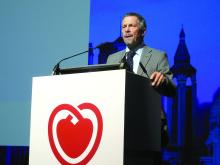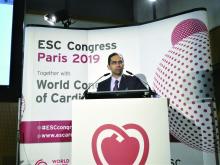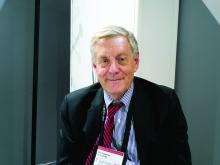PARIS – but that didn’t stop some experts from seeing a practice-changing message in its findings.
The results of PARAGON-HF, a major trial of sacubitril/valsartan – a compound already approved for treating heart failure with reduced left ventricular ejection fraction – in patients with heart failure with preserved ejection fraction (HFpEF), showed a statistically neutral result for the study’s primary endpoint, but with an excruciatingly close near miss for statistical significance and clear benefit in a subgroup of HFpEF patients with a modestly reduced left ventricular ejection fraction. These findings seemed to convince some experts to soon try using sacubitril/valsartan (Entresto) to treat selected patients with HFpEF, driven in large part by the lack of any other agent clearly proven to benefit the large number of patients with this form of heart failure.
HFpEF is “a huge unmet need,” and data from the PARAGON-HF trial “suggest that sacubitril/valsartan may be beneficial in some patients with HFpEF, particularly those with a left ventricular ejection fraction that is not frankly reduced, but less than normal,” specifically patients with a left ventricular ejection fraction of 45%-57%, Scott D. Solomon, MD, said at the annual congress of the European Society of Cardiology as he reported the primary PARAGON-HF results.
“I’m not speaking for regulators or for guidelines, but I suspect that in this group of patients [with HFpEF and a left ventricular ejection fraction of 45%-57%] there is at least some rationale to use this treatment,” said Dr. Solomon, professor of medicine at Harvard Medical School and director of noninvasive cardiology at Brigham and Women’s Hospital, both in Boston.
His suggestion, which cut against the standard rules that govern the interpretation of trial results, met a substantial level of receptivity at the congress.
Trial results “are not black and white, where a P value of .049 means the trial was totally positive, and a P of .051 means it’s totally neutral. That’s misleading, and it’s why the field is moving to different types of [statistical] analysis that give us more leeway in interpreting data,” commented Philippe Gabriel Steg, MD, professor of cardiology at the University of Paris.
“Everything in this trial points to substantial potential benefit. I’m not impressed by the P value that just missed significance. I think this is a very important advance,” said Dr. Steg, who had no involvement in the study, during a press conference at the congress.
“I agree. I look at the totality of evidence, and to me the PARAGON-HF results were positive in patients with an ejection fraction of 50%, which is not a normal level. The way I interpret the results is, the treatment works in patients with an ejection fraction that is ‘lowish,’ but not at the conventional level of reduced ejection fraction,” commented Deepak L. Bhatt, MD, professor of medicine at Harvard Medical School, who also had no involvement with PARAGON-HF.
Stuart J. Connolly, MD, designated discussant for the report at the congress and professor of medicine at McMaster University, Hamilton, Ont., struck similar notes during his discussion of the report, and called the subgroup analysis by baseline ejection fraction “compelling,” and supported by several secondary findings of the study, the biological plausibility of a link between ejection fraction and treatment response, and by suggestions of a similar effect caused by related drugs in prior studies.
The argument in favor of sacubitril/valsartan’s efficacy in a subgroup of PARAGON-HF patients was also taken up by Mariell Jessup, MD, a heart failure specialist and chief science and medical officer of the American Heart Association in Dallas. “I think it’s legitimate to say that there are HFpEF subgroups that might benefit” from sacubitril/valsartan, such as women. “I think it’s appropriate in this disease to look at subgroups because we have to find something that works for these patients,” she added in a video interview.
But Dr. Jessup also urged caution in interpreting the link between modestly reduced ejection fraction and response to sacubitril/valsartan in HFpEF patients because ejection fraction measurements by echocardiography, as done in the trial, are notoriously unreliable. “We need more precise markers of who responds to this drug and who does not,” she said.
PARAGON-HF randomized 4,796 patients at 848 sites in 43 countries who were aged at least 50 years, had signs and symptoms of heart failure with a left ventricular ejection fraction of at least 45%, had evidence on echocardiography of either left atrial enlargement or left ventricular hypertrophy, and had an elevated blood level of natriuretic peptides.
The study’s primary endpoint was the composite rate of total (both first and recurrent) hospitalizations for heart failure and cardiovascular death. That outcome occurred at a rate of 12.8 events/100 patient-years in patients treated with sacubitril/valsartan and a rate of 14.6 events/100 patient-years in control patients treated with the angiotensin receptor blocking drug valsartan alone. Those results yielded a relative risk reduction by sacubitril/valsartan of 13% with a P value of .059, just missing statistical significance. Concurrently with Dr. Solomon’s report the results appeared in an article online and then subsequently in print (N Engl J Med. 2019 Oct 24;381[17]:1609-20). The primary endpoint was driven primarily by a 15% relative risk reduction in hospitalizations for heart failure; the two treatment arms showed nearly identical rates of cardiovascular disease death.
Notable secondary findings that reached statistical significance included a 16% relative decrease in total heart failure hospitalizations, cardiovascular deaths, and urgent heart failure visits with sacubitril/valsartan treatment, as well as a 16% reduction in all investigator-reported events. Other significant benefits linked with sacubitril/valsartan treatment were a 45% relative improvement in functional class, a 30% relative improvement in patients achieving a meaningful increase in a quality of life measure, and a halving of the incidence of worsening renal function with sacubitril/valsartan.
The safety profile of sacubitril/valsartan in the study matched previous reports on the drug in patients with heart failure with reduced ejection fraction, an approved indication since 2015.
The key subgroup analysis detailed by Dr. Solomon was the incidence of the primary endpoint by baseline ejection fraction. Among the 2,495 patients (52% of the study population) with a left ventricular ejection fraction of 57% or less when they entered the study, treatment with sacubitril/valsartan cut the primary endpoint incidence by 22%, compared with valsartan alone, a statistically significant difference. Among patients with a baseline ejection fraction of 58% or greater, treatment with sacubitril/valsartan had no effect on the primary endpoint, compared with control patients. Dr. Solomon also reported a statistically significant 22% relative improvement in the primary endpoint among the 2,479 women in the study (52% of the total study cohort) while the drug had no discernible impact among men, but he did not highlight any immediate implication of this finding.
Despite how suggestive the finding related to ejection fraction may be for practice, a major impediment to prescribing sacubitril/valsartan to HFpEF patients may come from pharmacy managers, suggested Douglas L. Mann, MD, a heart failure specialist and professor of medicine at Washington University, St. Louis.
“The study did not hit its primary endpoint, so pharmacy managers will face no moral issue by withholding the drug” from HFpEF patients, Dr. Mann said in an interview. Because sacubitril/valsartan is substantially costlier than other renin-angiotensin system inhibitor drugs, which are mostly generic, patients may often find it difficult to pay for sacubitril/valsartan themselves if it receives no insurance coverage.
“It’s heartbreaking that the endpoint missed for a disease with no proven treatment. The study may have narrowly missed, but it still missed, and a lot of us had hoped it would be positive. It’s a slippery slope” when investigators try to qualify a trial result that failed to meet the study’s prespecified definition of a statistically significant effect. “The primary endpoint is the primary endpoint, and we should not overinterpret the data,” Dr. Mann warned.
PARAGON-HF was sponsored by Novartis, which markets sacubitril/valsartan (Entresto). Dr. Solomon has been a consultant to and has received research funding from Novartis and from several other companies. Dr. Steg has received personal fees from Novartis and has received personal fees and research funding from several other companies. Dr. Bhatt has been a consultant to and received research funding from several companies but has had no recent relationship with Novartis. Dr. Connolly and Dr. Jessup had no disclosures. Dr. Mann has been a consultant to Novartis, as well as Bristol-Myers Squibb, LivaNova, and Tenaya Therapeutics.





